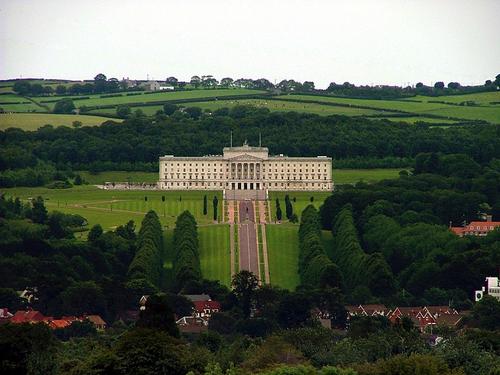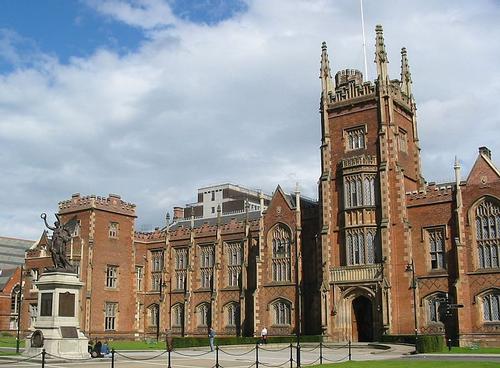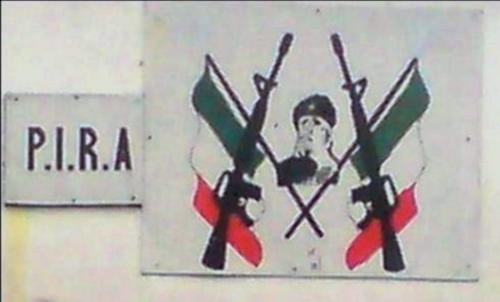NORTHERN IRELAND
Society

Society
Cities in NORTHERN IRELAND
| Belfast |
Popular destinations UNITED KINGDOM
| England | Northern ireland | Scotland |
| Wales |
Society
State structure
 Northern Irish Parliament BuildingsPhoto: Dom0803 CC 3.0 Unported no changes made
Northern Irish Parliament BuildingsPhoto: Dom0803 CC 3.0 Unported no changes made
Northern Ireland is part of the United Kingdom and is in transition to self-government after a period of political turmoil. In 1920, the Northern Irish Parliament or "Stormont" was established, consisting of a House of Commons and a Senate. In the same year, Northern Ireland was granted autonomy in internal affairs. At the time, the British Crown was represented by a governor. In 1972 domestic autonomy came to an end and the British Minister for Northern Ireland became the supreme authority. The Northern Ireland House of Commons was abolished in 1973 and replaced by an Assembly.
Northern Ireland was placed directly under British rule in 1974 and a new Assembly was elected in 1982. It was dissolved again indefinitely in June 1986, but the Assembly was reinstalled after the 1998 Good Friday Agreement.
The Assembly appoints the Prime Minister, who must assemble a government of both Catholics and Protestants, as the "Executive." The Assembly and the Executive have only limited powers: important matters such as public order and justice security are the responsibility of the British Secretary of State for Northern Ireland affairs.
Eight nationalist and loyalist parties are represented in the Assembly. Left-wing Sinn Féin is the highly controversial legal wing of the illegal Irish Republican Army (IRA), which until recently sought violence and terrorist reunification with Ireland.
Northern Ireland is sending eighteen members to the British House of Commons.
Northern Ireland is referred to in various ways. The most politically neutral term is "the North". Unionists prefer to speak of "the Province". Nationalists prefer "the six counties".
Ulster was the name of one of Ireland's four ancient counties. For the current political situation see chapter history.
Education
 Queens University Northern irelanPhoto: Man Vyi in the public domain
Queens University Northern irelanPhoto: Man Vyi in the public domain
The compulsory education in Northern Ireland applies to children between the ages of five and sixteen. The Department of Education governs all state-run schools. There are about 900 primary schools and about 230 secondary schools. There are also several schools for special and technical education and seventeen private schools.
Northern Ireland has several institutions for science scahepil education. The main universities are Queen's University and the University of Ulster. Queen's University from 1849 is Northern Ireland's oldest and most prestigious university with over 25,000 full-time and part-time students.
The University of Ulster opened in Coleraine in 1968.
Typically Northern Irish
IRISH REPUBLICAN ARMY or IRA
The Irish Republican Army or IRA is the name for several paramilitary organizations that call themselves the "Irish Republican Army". They strive, often by force, for an island-wide Irish state, with no ties to the United Kingdom.
They all say they are descended from the first Irish Republican Army, the "army" of the Irish Republic as it was founded by the Dáil Éireann in 1919. This group is referred to as the "Old IRA".
Furthermore, there are the:
 Mural PIRA Northern IrelandPhoto: Public domain
Mural PIRA Northern IrelandPhoto: Public domain
Provisional IRA (PIRA): a republican secession group in the 1970s, associated with Sinn Féin, known for the bombings between 1960 and 1990
The Real IRA: split from the PIRA
Continuity IRA: split from the IRA
Official IRA: no longer existing Marxist political party
On July 28, 2005, The IRA instructed its members to put an end to the armed struggle.
Sources
Cahill, M. J. / Northern Ireland
Chelsea House Publishers
Day, C. / North of Ireland
Cadogan
Wikipedia
CIA - World Factbook
BBC - Country Profiles
Last updated November 2025Copyright: Team The World of Info